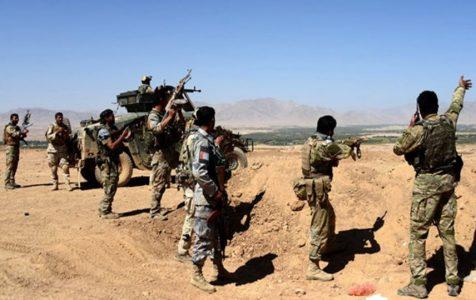
Afghan military targeted Al Qaeda’s terror network in Helmand
The Afghan military has launched multiple attacks against Al Qaeda’s network in the southern province of Helmand over the past week. Al Qaeda in the Indian Subcontinent, Al Qaeda’s regional branch that operates in South Asia, is known to operate in Helmand, where it also runs training camps.
The reporting on the raids against Al Qaeda targets by Afghanistan’s Ministry of Defense (MoD) is in direct contradiction with claims made by Zalmay Khalilzad, the U.S. Special Representative for Afghanistan Reconciliation. In his May 18 testimony to Congress, Khalilzad claimed that the Taliban has “made substantial progress in delivering on those [counterterrorism] commitments” which state that “the Taliban will not host, will not allow training, will not allow fundraising, will not allow recruitment of terrorists, including al Qaeda, that would threaten the security of the United States and our allies.” [See FDD’s Long War Journal report, Taliban maintains close ties with al Qaeda, DIA reports.]
The targets of the Afghan military operations include a “training center,” safe houses, the Taliban’s military liaison to Al Qaeda, and Al Qaeda soldiers, according to the MoD.
The Afghan Air Force struck an Al Qaeda “training center” in the district of Garmsir on May 20. According to a MoD press release, an “Al Qaeda “commander” known as including “Ali Punjabi” and “seven members of the Al Qaeda in the Indian Subcontinent network” were killed in the strike. His nom de guerre indicates that Ali Punjabi is from Pakistan.
The Afghan launched a separate airstrike in Lashkar Gah, the provincial capital, on May 23 and killed Maulvi Atiqullah, who was described as being “in charge of coordinating terrorist activities with Al Qaeda and the Taliban’s deputy commander for the province.” Atiqullah was also a member of the Taliban’s Red Unit, the Taliban’s version of special forces and shock troops, according to the MoD press release. The Red Units are typically at the tip of the spear in the fighting to take districts and key areas, and are known to cooperate with Al Qaeda. On the previous day, Afghan forces killed two other Red Unit commanders, identified as “Furqani and Bashir.”
On May 24, the Afghan military wounded “Haji Ulfat, a key Al Qaeda in the Indian Subcontinent commander” and killed four fighters in a strike “in the Popalzo area of Khanshin district.” Several “hideouts of the Al Qaeda terrorist network” were also targeted, the MoD reported. The AQIS fighters who were killed were described as “professional mine planters” who “were responsible for training terrorists in the use of night vision.”
Earlier in May, Afghan forces conducted two other raids in Helmand, both in Nahr-e-Saraj district. One strike killed five AQIS fighters, and the other killed three more. The AQIS fighters killed in the second raid “were residents of Punjab [Pakistan] and mine-laying experts who had come to the province to teach mine-laying,” according to the MoD.
The MoD’s reporting on AQIS operations in Helmand is consistent with outside sources. Al Qaeda is currently operating a training camp Baramcha in Disho district in Helmand province (FDD’s Long War Journal reported the existence of these camps in 2015.] The U.S. military killed Asim Umar, the head of Al Qaeda in the Indian Subcontinent, in the Taliban stronghold of Musa Qala in Helmand province on Sept. 23, 2019. Several Al Qaeda and Taliban leaders were killed alongside Umar, including the courier to Al Qaeda’s emir, Ayman al Zawahiri.
Al Qaeda is not merely confined to Helmand. Two other senior Al Qaeda leaders have been killed outside of Helmand over the past years. The U.S. military killed Husam Abd-al-Ra’uf, a veteran Al Qaeda leader who served as the group’s media chief, in a raid in Ghazni provicne in October 2020. One month later, Afghanistan’s National Directorate of Security killed Mohammad Hanif, another veteran jihadist who once served as the deputy emir of Al Qaeda in the Indian Subcontinent, during a raid in Farah province.
In May 2019, General Austin Miller, the commander of Resolute Support Mission and US Forces – Afghanistan, noted that Al Qaeda is operating “across the country” and not confined to one region. In March of the same year, the United Nations Security Council identified Al Qaeda to be operating in 13 of Afghanistan’s 34 provinces. A study by FDD’s Long War Journal that mapped the data relating to U.S military raids against Al Qaeda’s network in Afghanistan from 2007 to 2013 showed that Al Qaeda and its allies were operating in 25 of 34 of Afghanistan’s provinces.
Source: Long War Journal





